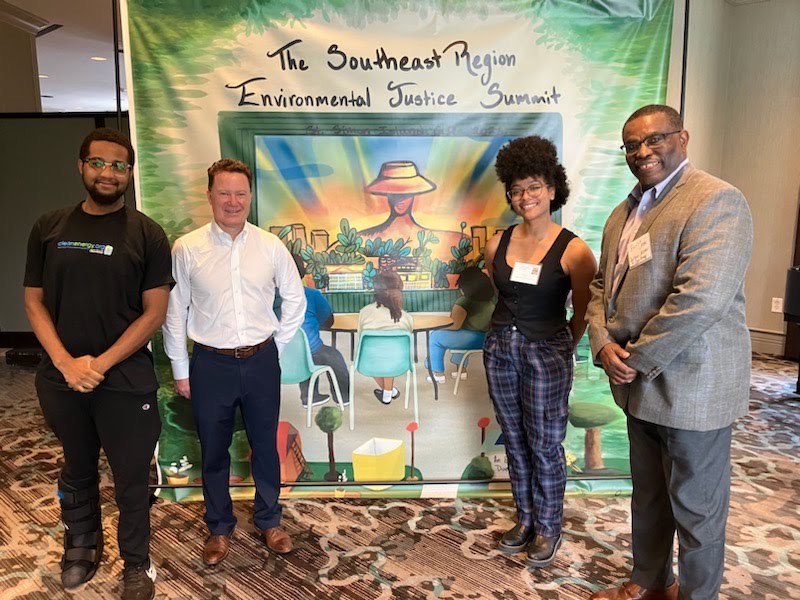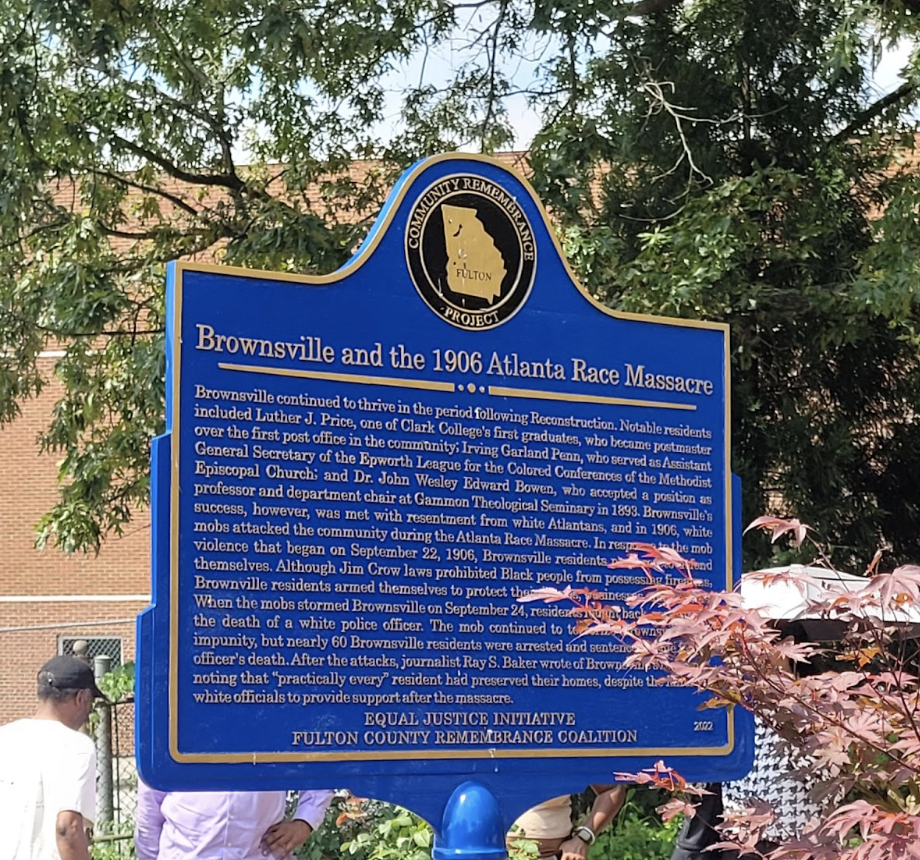On June 7th, Southern Alliance of Clean Energy staff joined over a dozen stakeholders for the Southeast Environmental Justice Summit in Atlanta, Georgia. The event was hosted by the Harambee House Citizens for Environmental Justice and aimed at advancing climate and environmental justice for everyone. SACE, along with other organizations, sponsored the five-day summit. Attendees learned about local and federal initiatives to promote environmental justice policies in the Southeast. Many organizations, including SACE, represented by Board Chair, Leon Jacobs, conducted panels to reaffirm and underscore the importance of environmental justice and how to combat years of environmental injustices in communities throughout the Southeast.

The Southeast Environmental Justice Summit had many great aspects. Here are a few highlights I took away from the event:
The Importance of Grassroots Policy
Change often begins on the local level, and it was one of the major themes of the summit. Grassroots organizations promote environmental justice by uplifting the voices of disadvantaged communities and holding local leaders accountable. The impact of climate change and environmental injustices is often felt the most in underprivileged communities. They often suffer from health issues such as asthma from overexposure to air pollution. The burden forces locals of these diverse communities to take action, find solutions, and demand change and resources from their local and federal representatives.
“Environmental Justice Studies is a social justice activity because marginalized communities are hit hardest, physically, economically and emotionally, by pollution and environmental threats.” – Leon Jacobs, SACE Board Chair
Community-driven solutions promote community engagement by addressing challenges specific to the community. Jacobs also highlighted that the EJ movement correlates to the Civil Rights Movement, as both relied on coalition building and community empowerment to push for change. Environmental Justice advocates partnered with underserved communities suffering from environmental hazards such as overexposure to air pollution and brought the issues to the forefront of their respective representatives. Environmental justice advocates continue to push for a clean and healthy environment, specifically in historically underserved communities and at the whims of pollution.
The work of environmental justice activists empowers disadvantaged communities by elevating the voices of the community and helping hold their representatives accountable. The issue of environmental justice necessitates community engagement as there is no “one-size fits all” solution for environmental justice. The Southeast contains many diverse communities, and they must feel empowered to find solutions best tailored to improve their respective community.
The major takeaway is that a community-driven approach to achieving environmental justice is critical, as the voices of disadvantaged communities must be empowered to affect change locally. Grassroots activists will continue to play a vital role in ensuring all communities are heard. Still, locals of disadvantaged communities must feel empowered to engage local leaders to ensure future environmental policies positively impact them. SACE helps to uplift underprivileged communities by elevating their voices and supporting their goals of achieving clean and equitable communities. By working with the Clean Energy Generation movement, SACE empowers locals and communities to harness the benefits of clean energy and provides a better future for the next generation.
Implementing Major Federal Policy
The Bipartisan Infrastructure Law (BIL) and the Inflation Reduction Act (IRA) provide significant funding to help achieve advocates’ goals of all communities living in a clean and healthy environment. Speakers during the summit honed in on various avenues to best implement funds from IRA and BIL to help underserved communities. Ideas included improving local transit, youth engagement in understanding local environmental hazards, and assisting communities in applying for funding. Many ideas focused on improving public transit in the southeast, utilizing electric vehicles, specifically electric buses, and trains. While funds from the federal government are plentiful, there is an urgency to implement the policies from IRA and BIL, as any unspent funds could be jeopardized depending on the outcome of upcoming elections in 2024.
Justice40 was also a major topic of discussion. The goal of Justice40 is to direct 40% of the overall benefits of specific federal investments – such as clean energy, clean transportation, and workforce training, towards disadvantaged communities. According to the Department of Energy, a Justice40 impoverished community is determined by meeting thresholds such as environmental or climate burdens such as pollution and socioeconomic burdens. But since local and state governments largely dictate how the money they receive from the federal government gets used, it’s unclear how a program like Justice40 will be enforced — specifically in states like Florida and Georgia, where Republican leadership has continued to defy federal guidance. However, one way to adapt to this stumbling block is to encourage cities to use federal funding from the IRA or BIL that the state does not and embrace Justice40 initiatives. Implementing significant climate legislation in the Southeast highlights the push-and-pull of states’ rights vs. the federal government and why environmental advocates must continue to adapt and persevere in advocating better policy.
“Those Who Do Not Learn History Are Doomed To Repeat It.”
We can’t achieve environmental justice without understanding the history of our region. The legacy of the Southeast will always be linked to the civil war, as Southern states succeeded from the Union and created the Confederate States of America in a violent attempt to preserve the institution of slavery. While being known for the progressive slogan “the city too busy to hate,” Atlanta also grapples with its dark past. One of the many impactful parts of the conference was the city bus tour that highlighted old neighborhoods formerly populated by African-Americans but that was demolished as the city increased in population due in part to gentrification. One of the guides during the tour, Dr. Erica Hill, highlighted the environmental contrast between different Atlanta neighborhoods, underlining the need for grassroots environmental justice advocacy. The guides underscored the lack of tree canopies in lower-income Atlanta neighborhoods compared to the lush tree canopies in affluent areas such as Buckhead. Summers in Atlanta are hot, and trees that block the sun provide much-needed shade. Collaborating with underprivileged areas that lack precious tree cover could get these areas much-needed relief and open the door for more sustainable advocacy in those communities.

The last leg of the tour was at the abandoned Chattahoochee Brick Company and an area in downtown Atlanta commemorating the 1906 Atlanta Race Massacre. The visit to the old Brick Company was unforgettable. The Chattahoochee Brick Company is infamous for its extensive use of convict lease labor in the late 1800s. Hundreds of African Americans were used, toiling in conditions not dissimilar to slavery. Currently, the site is neglected, with small brick walls still standing from its past. The work left the area with toxic material, and the city, with the help of a $2 million grant from the Environmental Protection Agency from BIL, will aid in cleaning up hazardous material at the old site. The tour concluded on 112 Courtland Street SE, commemorating the 1906 Atlanta Race Massacre victims. The massacre was caused by fear-mongering of Black economic success spurred by the 1906 gubernatorial race between Clark Howel and Hoke Smith. Both candidates attempted to win the white vote by advocating the disenfranchisement of Black residents in the city. Twenty-seven people, mostly Black, were killed, leaving a lasting scar on the city. Both of these tragedies are heartbreaking but important to the story of Atlanta and the intersectionality between civil rights and environmental justice.
The biggest takeaway from the summit for me was that as environmental advocates, we must fully understand the history of our communities to create meaningful change and avoid grouping the Southeast as a monolith. To appropriately advocate for communities, we must understand their history and work with community leaders to amplify their voices and push for change.
Thank you to the Harambee House for hosting an enlightening and collaborative summit that championed the environmental justice movement. The Summit highlighted the progress made to achieve environmental justice and the work that still needs to be done.
The Southern Alliance for Clean Energy’s Electrify the South program leverages research, advocacy, and outreach to accelerate the equitable transition to electric transportation across the Southeast. Visit ElectrifytheSouth.org to learn more and connect with us.